You have no items in your shopping cart.
0
You have no items in your shopping cart.
With the use of Soft Shackles made from a 12-strand Dyneema Rope becoming more and more popular, there are a number of questions popping up about how they perform and how safe they are to use. A few of these questions are "How to they hold up around sharp edges?", and "What about abrasion, does it affect the strength?", or "Does triloading weaken soft shackles?". I would like to test these things. This is what this article showcases, the testing of soft shackles in a number of different facets to determine their usability for slackline rigging.
I suspect that soft shackles are more resilient than they appear to be. Knowing how well Dyneema holds up in extreme environments under significant stress makes me believe that it will be hard to do significant damage to them, regardless of the circumstance.
We will be discussing 3 different tests in this article:
We will start with a length of 3/16" Amsteel Blue (coated green), rated at a breaking strength of 5,400 lbf by Samson Ropes (seen here: http://samsonrope.com/Pages/Product.aspx?ProductID=872). We will be making as many soft shackles as we can from this length of rope.
This size of Amsteel is exceptionally small for this type of application. We had to use a small size due to the capacity of the break test machine. If you are thinking of making your own soft shackles, USE 5/16" AMSTEEL! This will ensure you have a strong enough connector for any type of line you rig.
Using the exact same length of rope for each soft shackle (48 inches), we will use the Diamond Knot technique (shown here: http://www.animatedknots.com/softshackle/) to make these soft shackles.
Each soft shackle will have the knot set to 2,000 lbf using the break test machine, all during the same evening.
Through random selection, we assigned 3 soft shackles to each of the test groups above and 3 to our control group.
The control group will be untreated soft shackles broken between two 5/8" shackles in a straight pull configuration.
The sharp edge test will use a 3/16" thick stainless steel plate with a hole drilled through. The soft shackle will attach directly to this hole (very sharp edges) and the other end straight to a 5/8" shackle bolt. We then pulled the samples to failure
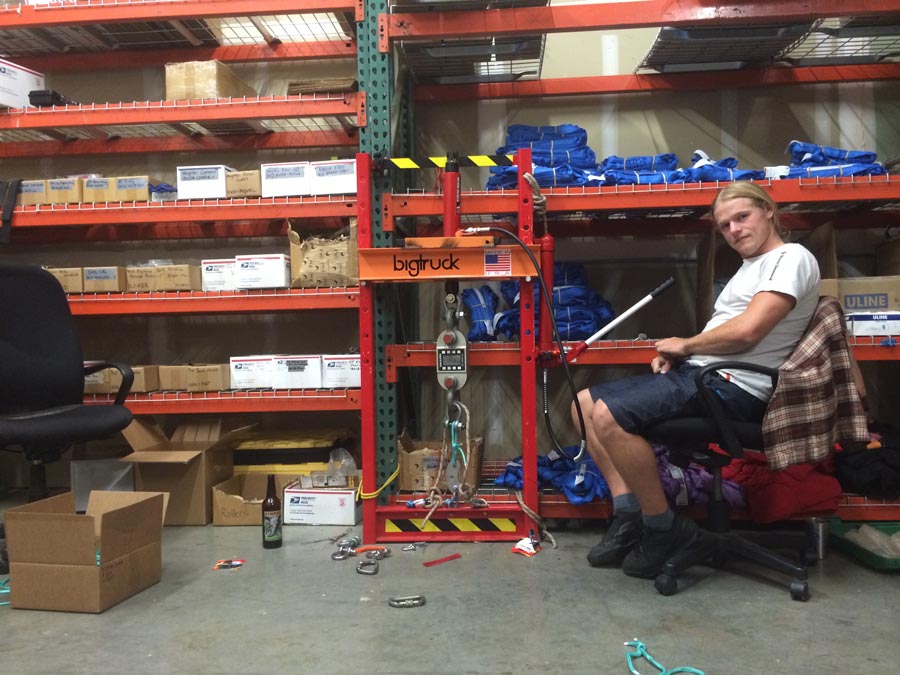
The tri-load test will use 3 anchor points: 2 of which are 5/16" shackles going to the base-plate on the break-test machine and then the third point to the hydraulic cylinder, which is a 5/8" shackle. We then pulled the samples to failure.

The abrasion test is a bit more complicated. We first rigged a 4 point sliding-x anchor with 8mm static rope and connected it to the 4 points with quicklinks attached to small cords that could easily be cut. At the master point of the sliding-x was a soft shackle going to a weblock. We then rigged a similar thing on the other anchor and tensioned a slackline to 2,000 lbf using Type 18 MKII. After the desired tension was reached, we cut one of the small cords on the soft shackle anchor, allowing the anchor to extend out, re-equalizing the 3 remaining points, abrading the soft shackle as it extended out. We then pulled the samples to failure between two 5/8" shackles.
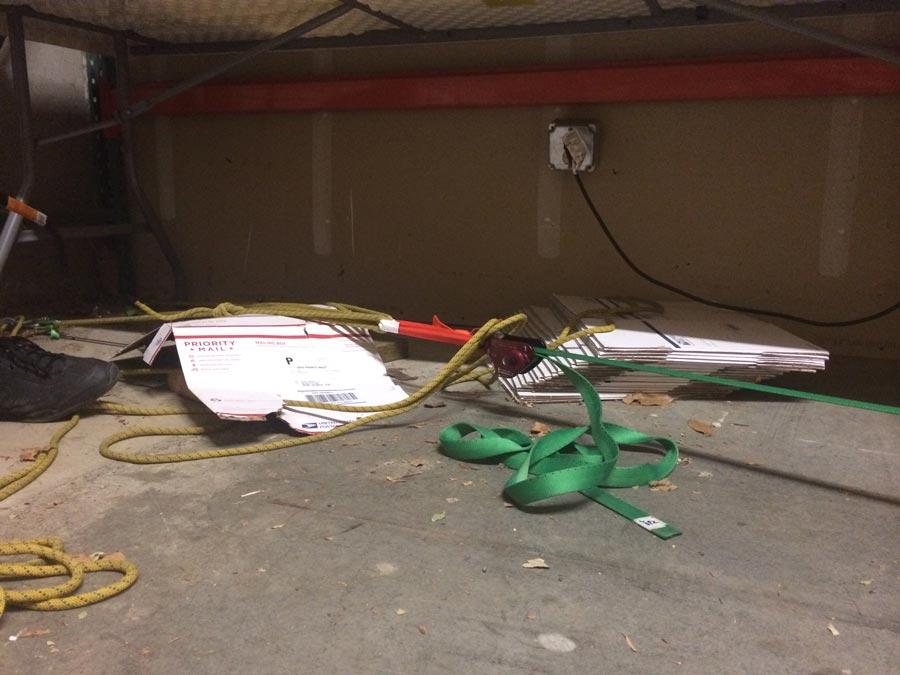
All data was analyzed using a student t-test to determine statistical significance. Results were considered statistically significant if p<0.05.
Here is a table of our results:
| Test | Sample 1 | Sample 2 | Sample 3 |
|---|---|---|---|
| Control | 7,128 lbf (31.7 kN) | 8,438 lbf (37.5 kN) | 7,616 lbf (33.9 kN) |
| Sharp Edges | 4,800 lbf (21.4 kN) | 5,712 lbf (25.4 kN) | 6,062 lbf (27.0 kN) |
| Tri Load | 7,324 lbf (32.6 kN) | 8,496 lbf (37.8 kN) | 9,070 lbf (40.3 kN) |
| Abrasion | 7,800 lbf (34.7 kN) | 8,496 lbf (37.8 kN) | 6,776 lbf (30.1 kN) |
As we can see here, the only test that showed any significant change to the breaking strength is the sharp edges test. Sharp edges significantly reduces the breaking strength of soft shackles made from 3/16" Amsteel Blue by 28% (p = 0.014).
Here are videos showing the tests:
Sharp Edges - https://www.youtube.com/watch?v=50PgBAFv4UE
Tri-Load - https://www.youtube.com/watch?v=8fB3m5pPgdo
Abrasion - https://www.youtube.com/watch?v=n2AhcsECsQc
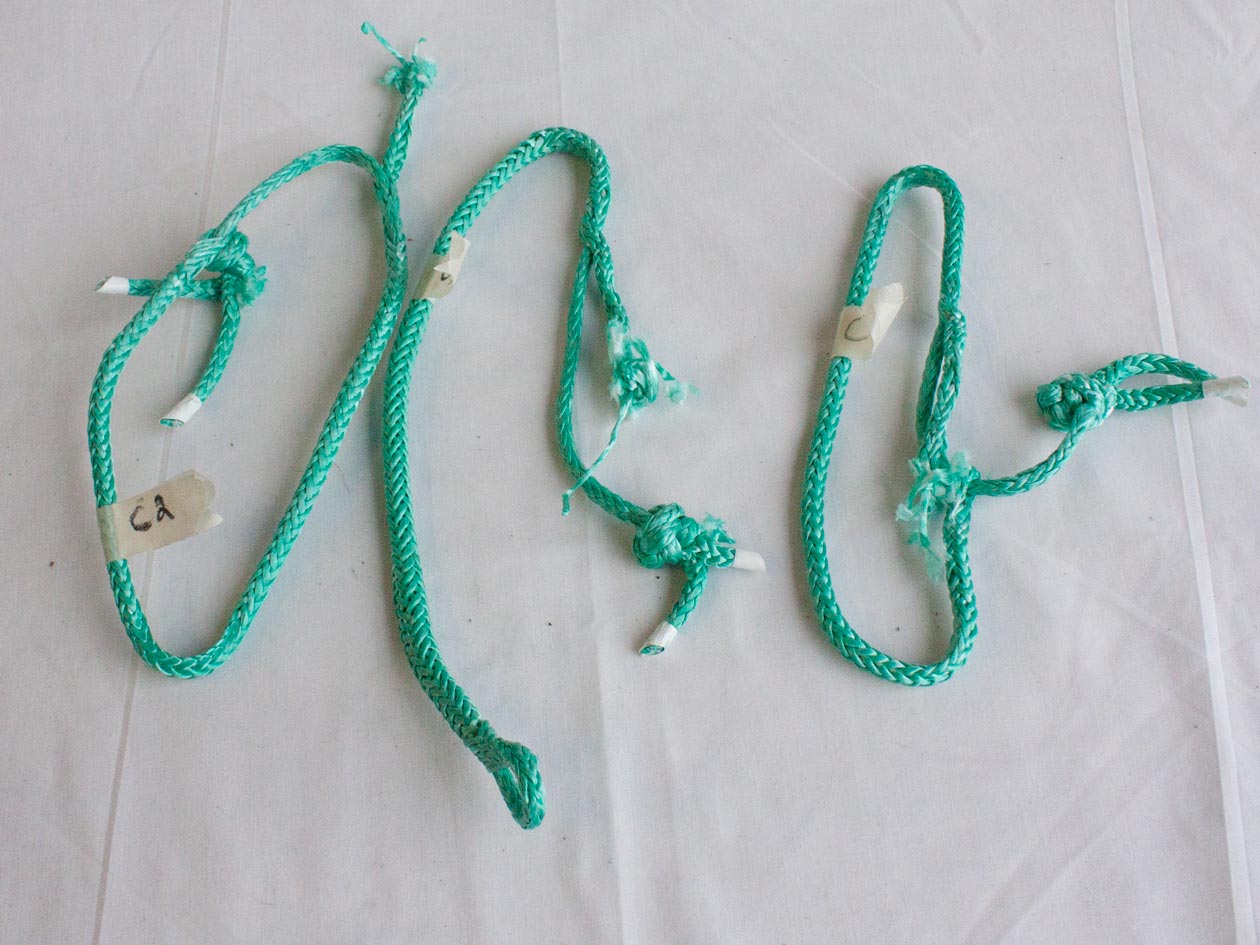
Control Samples
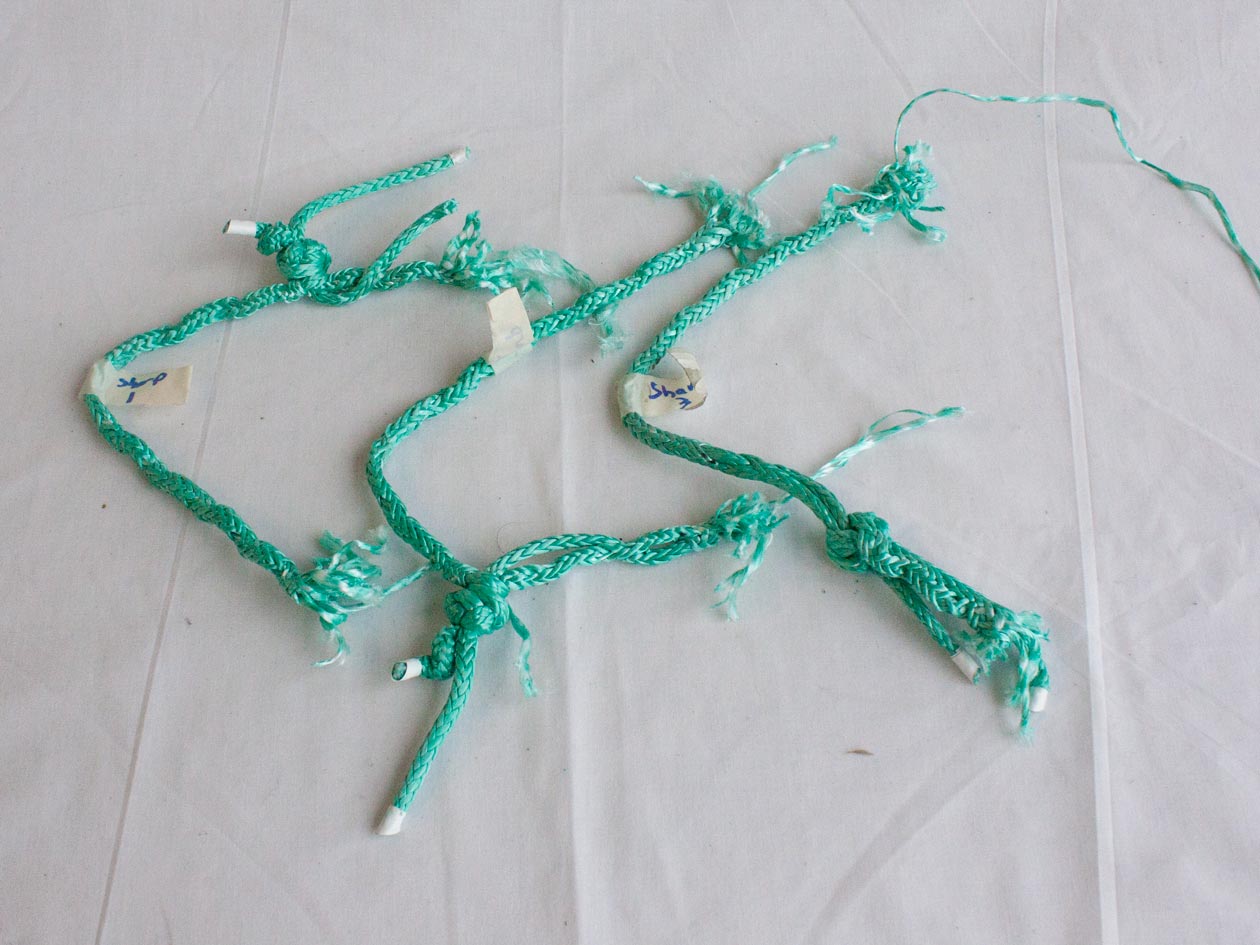
Sharp Edge Samples
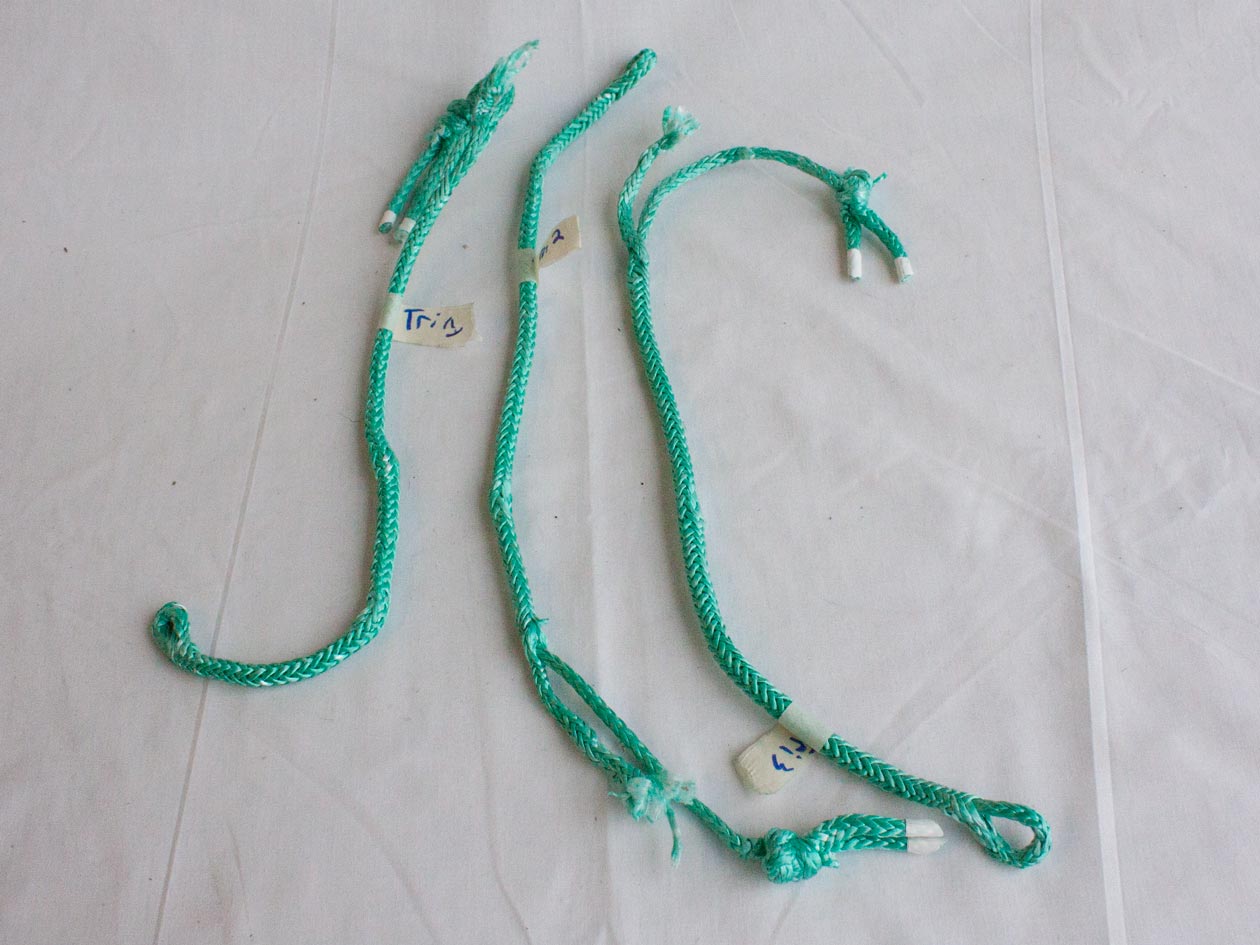
Tri-Load Samples

Abrasion Samples
The results of these tests give me a lot of confidence in the sturdiness of soft shackles. Even in the most extreme of cases where sharp edges can lower the breaking strength of the soft shackle, they still far exceed any sort of strength requirement we need in our application. I will say that the potential to damage soft shackles from repeated use on sharp edges is very high. I would sleeve the soft shackles using some specialized sleeving material to prevent this sort of thing from happening and increase the lifespan of the soft shackle.
Soft shackles are still very new in the slackline rigging world. I would like to do some long-term testing of soft shackle use, seeing how well they withstand multiple uses over the course of several months / years. I would also like to see cyclic loading tests done on soft shackles.
Beyond this, I think time will tell how well soft shackles will work for our industry.
| Product | Price | Quantity | Options | |||||
|---|---|---|---|---|---|---|---|---|
| Features |
| Availability: |
| Price |
| Options |
| Actions |

← Older Post Newer Post →
1 comment
Thanks for posting this well thought out and instructive article